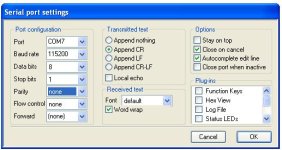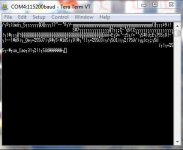########################################
# (c)opyright 2012, B.M. Putter #
# Adliswil, Switzerland #
# bmp72@hotmail.com #
# #
# experimental, use at your own risk #
########################################
a] calibrate hall sensors
b] determine coil positions
c) PWM parameters
d) current settings
e) control loop parameters
f) throttle setup
g) running modes
h) CAN bus setup
z) store parameters in EEPROM for motor use
------> c
a) PWM frequency: 20kHz
b) deadtime: 599ns
c) dutycycle testsignal: 50%
d) toggle high side polarity, now active HIGH
e) toggle low side polarity, now active HIGH
f) test PWM signals
z) return to main menu
------> z
########################################
# (c)opyright 2012, B.M. Putter #
# Adliswil, Switzerland #
# bmp72@hotmail.com #
# #
# experimental, use at your own risk #
########################################
a] calibrate hall sensors
b] determine coil positions
c) PWM parameters
d) current settings
e) control loop parameters
f) throttle setup
g) running modes
h) CAN bus setup
z) store parameters in EEPROM for motor use
------> d
a) number of current sensors: 2
b) current sensor transimpedance: 10.00 mV/A
c) maximum motor phase current: 19.9 A
d) maximum battery current, motor use: 4.9 A
e) maximum battery current, regen: 0.0 A
f) maximum shutdown error current, fixed: 1.9 A
g) maximum shutdown error current, proportional: 1.9 A
h) IIR filter coefficient: 5
i) use additional comb filter: YES
z) return to main menu
------> z
########################################
# (c)opyright 2012, B.M. Putter #
# Adliswil, Switzerland #
# bmp72@hotmail.com #
# #
# experimental, use at your own risk #
########################################
a] calibrate hall sensors
b] determine coil positions
c) PWM parameters
d) current settings
e) control loop parameters
f) throttle setup
g) running modes
h) CAN bus setup
z) store parameters in EEPROM for motor use
------> e
a) loop sample frequency: 38.01 kHz
b) 1st order phase loop integrator coefficient: 12.7999
c) 2nd order phase loop integrator coefficient: 0.0709
d) amplitude loop integrator coefficient: 3.0000
e) maximum amplitude: 200 %
z) return to main menu
------> z
########################################
# (c)opyright 2012, B.M. Putter #
# Adliswil, Switzerland #
# bmp72@hotmail.com #
# #
# experimental, use at your own risk #
########################################
a] calibrate hall sensors
b] determine coil positions
c) PWM parameters
d) current settings
e) control loop parameters
f) throttle setup
g) running modes
h) CAN bus setup
z) store parameters in EEPROM for motor use
------> f
a) calibrate throttle 1
b) calibrate throttle 2
c) polynomal coefficients throttle 1 (x, x^2, x^3): 1.0000, 0.0000, 0.0000
d) polynomal coefficients throttle 2 (x, x^2, x^3): -0.0002, -0.0002, -0.0002
e) use analog throttle 1: YES
f) use analog throttle 2: NO
receive throttle over CAN: NO
g) TX throttle over CAN: NO
h) test throttle
z) return to main menu
------> z
########################################
# (c)opyright 2012, B.M. Putter #
# Adliswil, Switzerland #
# bmp72@hotmail.com #
# #
# experimental, use at your own risk #
########################################
a] calibrate hall sensors
b] determine coil positions
c) PWM parameters
d) current settings
e) control loop parameters
f) throttle setup
g) running modes
h) CAN bus setup
z) store parameters in EEPROM for motor use
------> g
a) sensored or sensorless: SENSORLESS
b} sensorless startup: SELF START
c} e-rpm limit sensorless self start: 382
d} e-rpm reached before transition: 81 %
e} minimum current push start: 4.9 A
f} push start current, error allowed: 25 %
g] erpm sensored to sensorless transition: 500
h] transition time sensored to sensorless: 99 milli-sec
i) return to motor start below 107 erpm
j) controlled slowdown for direction change: YES
k) phase current for controlled slowdown: 0.9 A
l) motor maximum, forward: 39.99 k-erpm
m) motor maximum, reverse: 3.96 k-erpm
n) motor standstill voltage threshold: 0.49 V
z) return to main menu
------> z
########################################
# (c)opyright 2012, B.M. Putter #
# Adliswil, Switzerland #
# bmp72@hotmail.com #
# #
# experimental, use at your own risk #
########################################
a] calibrate hall sensors
b] determine coil positions
c) PWM parameters
d) current settings
e) control loop parameters
f) throttle setup
g) running modes
h) CAN bus setup
z) store parameters in EEPROM for motor use
------> h
a) CAN 'address': 1990
b) CAN CFG1 as per Microchip 30F manual: 64
c) CAN CFG2 as per Microchip 30F manual: 664
RS232 output rate: 3802 Hz
z) return to main menu
------> z
########################################
# (c)opyright 2012, B.M. Putter #
# Adliswil, Switzerland #
# bmp72@hotmail.com #
# #
# experimental, use at your own risk #
########################################
a] calibrate hall sensors
b] determine coil positions
c) PWM parameters
d) current settings
e) control loop parameters
f) throttle setup
g) running modes
h) CAN bus setup
z) store parameters in EEPROM for motor use
------>





